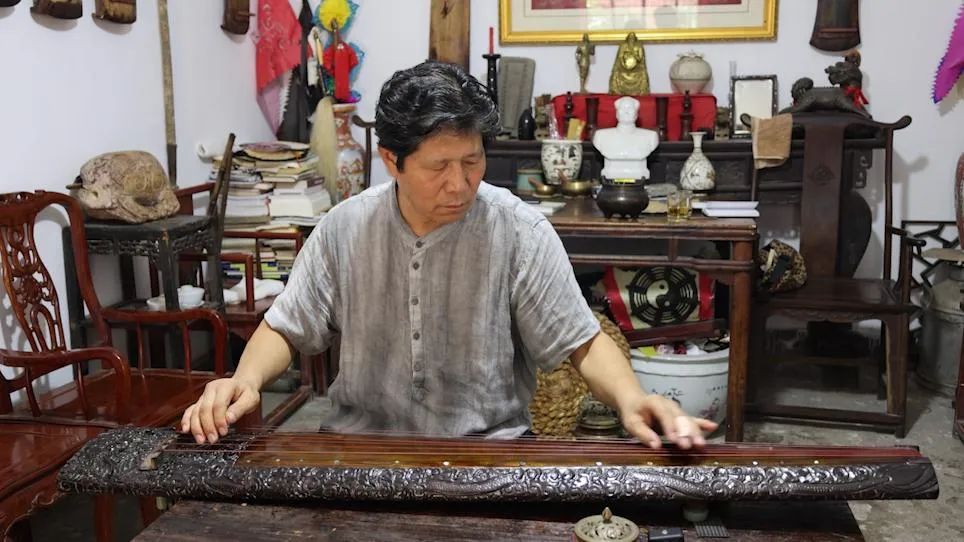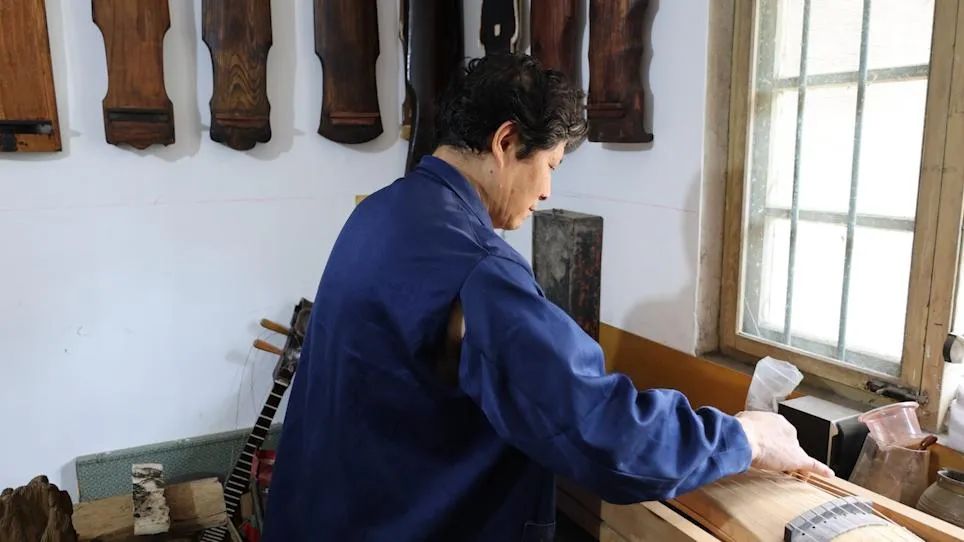Touch the memory of the city and inherit the centuries-old Xie's ancient method
In 2020, Xie's ancient method of qin became an intangible cultural heritage in Xi'an. With the support of Xi'an High-tech Zone, a series of intangible cultural heritage sports exhibitions and performances for the 14th National Games, intangible cultural heritage exhibitions and studies in the pre-14th National Games were held. The event will let more people know about Xie's ancient method of qin, a traditional skill that has been handed down for a century.

Guqin, started from Fuxi. According to the "Sounds of Ancient Times", Fuxi saw that the phoenix was gathered in the tong, so he cut the tong according to its shape and "made it into a qin". Legend has it that when Fuxi inspected the Tonglin forest, he saw that the sun was shining brightly. Therefore, Fuxi believed that the phoenix tree was a very good wood, so he took the middle section of the phoenix tree to make the first qin between heaven and earth, and later named the qin style Fuxi style.
"Guqin, the earliest stringed musical instrument of the Han nation, has a long inheritance history of 3,000 years. From the ritual instrument that communicated the heaven and the earth in the pre-Qin period to the Taoist instrument for self-cultivation and self-cultivation by the literati of later generations, its tone is ancient, transparent, mellow, mellow in bass, and mellow. High-pitched and clear. It has been a favorite tool in the hands of ancient Chinese literati and scholars for thousands of years.” Xie Shuangxu said.
Sitting in the Xie's Guqin-making workshop in Nanwutai Ancient Town, Xie Shuangxu, the seventh-generation inheritor of Xie's ancient intangible cultural heritage of Xi'an, accompanied by the sound of cicadas, watched the ancient scenery outside the door for us. Telling the legend of the guqin, Xie's ancient method of picking the qin.
Laymen appreciate the guqin, and they all look the same. At first glance, they can only see that the carvings and decorations on the guqin are different. In fact, there is a lot behind the shape of the guqin.
"The common ones are Fuxi style, Zhongni style, Lianzhu style, Luoxia style, Shennong style, Xiangquan style, etc. The shapes are mostly recorded in ancient books and passed down from generation to generation by qin masters. For example, Fuxi style is round and simple in shape, with different neck and waist. The half-moon shape is curved in, and the arc is exquisite. Its timbre is generous, and its stroking is as distant as the sound of the world." Follow Xie Shuangxu into the woodworking room of Xie's Guqin Crafting Workshop. There are guqins of different shapes hanging on the wall. The shape of bed guqin has a lot of origin, or it is a sage man-made qin, or it is derived from the influence of the four great masters of China, traditional poetry, and myths.
The making of a guqin usually takes at least 30 traditional processes and takes two years to complete. Jiqin is a kind of craftsmanship for the meticulous work of the guqin, which requires a professional and technical luthier to complete the operation. From entry to teaching the next generation of ancient qin skills, the two brothers Xie have been qin for more than 20 years, and they are proficient in more than 40 types of guqin making methods.
"Guqin is very particular about the selection of materials. Only the Qinling woods that have endured hundreds of years of wind, frost, snow and moon can withstand the heavy task of playing for a hundred years." Xie Shuangxu put the wood embryos that had been cut into the prototype of the guqin on the work table and took them. Picking up a pencil to outline the guqin shape lines that have been covered on the wood, this is the third step of Xie's ancient method of qin - customizing.
After the outline of the shape was completed, Xie Shuangxu picked up the wooden chisel and started the groove. The groove directly determines the sound quality of the guqin and is the soul of a qin. This step is very important. The aesthetic requirements formed by the qin masters accumulated over decades of experience, and they have to audition while listening to whether the sound of the guqin achieves the desired cleanliness and purity.

When the sound is clear, transparent and round, you can buckle the bottom plate of the guqin on it, complete the step of synthesizing the piano, and attach the desired accessories. It is then sent to the paint booth for a year-long painting process. Entering the paint room, the air is filled with the smell of soil mixed with the trees themselves. This is because the lacquer used in Guqin is natural lacquer (also known as lacquer), and lacquer contains plant esterase, which can cause skin allergies, itching and swelling when directly contacted.
The lacquer needs to wait until it is completely dry before applying the second lacquer, and a total of three painting processes are required. This time Xie Shuangxu came to paint the second lacquer on this batch of pianos, which were made by Xie Shuangxu's students.
"In addition to material selection, setting, modeling, tank belly, sound identification, and painting, there are more than 30 traditional processes such as hemp wrapping, tire setting, polishing, sound audition, thickness adjustment, tuning, polishing, and stringing. It includes a lot of small piano-making steps." Xie Shuangxu said. A guqin is not easy to come by, and it cannot be separated from the countless polishing of the qin master. It tests the patience and determination of the qin master. When asked about the qin that Xie Shuangxu is most satisfied with, he only thinks that the qin he made by himself will always last forever. Need to learn to polish.
Xie Shuangxu, who loves guqin so much, did not learn to play and play guqin when he was a child.
Xie Shuangxu was born in the compound, an old Xi'an native, and the people living in the compound infected him. "My parents and the elders living in the yard are very fond of traditional culture. When I was a child, I liked to play the piano with them and write and write with them. When I was a little older, we couldn't put it down. It was an opportunity for our brothers. When the two learned about guqin, they began to have a hobby of guqin." Xie Shuangxu said that in the process of learning the qin, the brothers met Mr. Li Jianzheng, their mentor, and Xie Shuangxu recalled the scene when the teacher decided to teach the two of them the skill of qinqin.
"In the early years, my brother and I consulted teachers everywhere in order to learn the guqin well, and only then did we find Mr. Li Jianzheng. After entering the house, we met the old man and we talked for a long time, from playing the guqin to playing the qin, and it was also because of us. His persistence moved the teacher and decided to teach it to our brothers Xie." Xie's ancient method of qin is based on the Shu style qin, and while inheriting the skills of the predecessors, it integrates the generous and atmospheric characteristics of the northern guqin represented by Li Jianzheng. The sound of the guqin produced is transparent, clear and quiet, and has a long aftertaste.
Xie Shuangxu began to work while playing the piano in 1995, and in 2002 he opened his first piano studio. "Opening a qin hall is to meet a group of close friends who love traditional music. Through their support in twos and threes, the qin hall can barely sustain itself." Xie Shuangxu could not rely on the guqin to solve the problem of eating. In addition to the guqin, he also engaged in the collection and restoration of some literary toys. The job can also bring him some income. Taking apprentices to learn the piano and other side jobs will solve the problem of food and clothing.
Xie Shuangxu and Xie Mengxu started research activities in 2012. Guqin enthusiasts and students from all over the world came to Xie's Guqin-making workshop to experience the traditional skill of ancient-style qin-handling. In 2017, the two brothers expanded their study place and opened a training center to provide an opportunity for traditional culture lovers to communicate. "In the training center, we not only study the ancient method of qin and playing skills. We also study traditional Chinese culture together, enrich the classroom, taste the works of traditional masters, and praise ancient poetry and songs. This can be for those who truly love traditional culture. , to provide a sophisticated place in the noisy city." Xie Shuangxu said.
However, the production of guqin involves a series of craftsmanship skills such as playing, carving, tuning, debugging, and lacquer, so the qin master is not only a carpenter, but also needs to understand music theory. Due to a series of factors such as the long construction period and the incomprehensible guqin music theory, very few people can carry on the inheritance of the ancient qin skills.
"We do not have a high threshold for accepting students. We welcome anyone who wants to learn, but as an inheritor, the threshold has to be higher. After all, if the inheritor we accept after we die, he will give up if he says he will give up, and no one can do this skill. Pass it on." Xie Shuangxu sighed as he looked at the guqin hanging on the wall.
For Xie Shuangxu and Xie Mengxu, guqin is a lifelong hobby. And when the burden of inheritance falls on their shoulders, it is not as simple as a hobby to play the ancient qin and guqin. The traditional skill of barely maintaining food and clothing requires decades of perseverance and always maintaining the original hobby. This is difficult for most people. The road to inherit this skill and spread the traditional Chinese guqin culture still needs to go a long way. .
A guqin plays a long aftertaste, a traditional skill, behind which is the traditional Chinese culture passed down from generation to generation. Every qin style and every guqin piece carries traditional Chinese myths and stories, humanistic history, Tang poetry and Song poetry, and is the condensation of thousands of years of traditional Chinese culture.
Love can last for a long time. The Xie brothers regard traditional Chinese culture as the root, the guqin as a shade tree, and the ancient method of qin skills into branches and leaves. People who love guqin are always welcome and inherit the experience of ancient qin. Thousands of years of intangible cultural heritage skills jointly protect the roots of Chinese traditional culture.
 渝公网安备 50010702504639号
渝公网安备 50010702504639号